As an Amazon Associate KitchenwareSets.com earns from qualifying purchases.
11 Warm Neutral Kitchen Ideas That Look Expensive on Any Budget
Do you scroll through Pinterest and dream of a kitchen that feels like a warm hug—sophisticated, cozy, and effortlessly chic—only to be snapped back to reality by your own cold, sterile, or outdated space? You see the luxurious designs, the custom cabinetry, and the perfect lighting, and the immediate thought is, “That’s beautiful, but completely out of my budget.” It’s a common frustration, feeling like a high-end kitchen is a world away from what your bank account will allow.
You’re not alone in this. Many homeowners believe that achieving an expensive look requires a gut renovation and a five-figure price tag. They see their stark white or dated gray kitchen and feel stuck, unsure how to inject that coveted warmth and personality without breaking the bank. The fear of choosing the wrong paint color or making a costly mistake can lead to analysis paralysis, leaving you with a kitchen that just doesn’t feel like you.
Here’s the secret: A warm neutral kitchen achieves a high-end look by layering creamy off-whites, beiges, and taupes with natural textures like wood and stone. Strategic, budget-friendly upgrades to hardware, lighting, and backsplashes create a custom feel, while intentional decluttering ensures a sophisticated, polished aesthetic that looks expensive on any budget.
Dreaming of a Cozy, High-End Kitchen Without the Hefty Price Tag?
The desire for a kitchen that is both beautiful and functional is universal, but the key to achieving a luxurious feel without overspending lies in a warm neutral color palette. Unlike the cool grays and stark whites that can sometimes feel clinical, warm neutrals provide a timeless and inviting foundation that you can build upon. We’ve distilled lessons from countless high-end designs and budget-savvy renovations to bring you a proven blueprint for affordable luxury. This isn’t about a massive overhaul; it’s about making smart, impactful choices.
What Exactly is a “Warm Neutral” Palette?
A warm neutral palette consists of colors like beige, cream, taupe, and greige that have subtle yellow, red, or pink undertones. These undertones are what differentiate them from cool neutrals (like stark white or blue-gray) and give them the ability to create a cozy, inviting, and calming atmosphere in a kitchen. As design strategists, we always start by sampling colors, because understanding how light affects these undertones is critical.
- Beige & Tan: Classic warm neutrals that bring an earthy, sandy feel to a space.
- Cream & Off-White: Softer alternatives to stark white, they provide brightness without the coldness. Think Benjamin Moore’s Swiss Coffee.
- Taupe & Greige: These are complex neutrals that blend gray with beige (greige) or brown (taupe). They can shift beautifully in different light, like Sherwin-Williams’ Accessible Beige.
- Mushroom: A sophisticated, earthy color that sits between beige and gray, offering a modern yet warm feel.
Pro Tip: The secret to choosing the right warm neutral is observing it in your own kitchen’s light. A greige that looks perfect online might pull too much green in your north-facing kitchen. Always paint a large sample swatch on your wall and look at it in the morning, afternoon, and evening before committing.
11 Warm Neutral Kitchen Ideas That Look Expensive on Any Budget
Ready for a transformation? You don’t need a massive budget to make a massive impact. Each of these 11 ideas is selected from high-performing designer kitchens and adapted to be achievable on a real-world budget, updated for 2025. From simple weekend DIYs to slightly more involved updates, there’s a starting point here for every skill level and wallet. Let’s dive in and create the warm, inviting kitchen you’ve been dreaming of.
1. Embrace Creamy, Off-White Cabinet Colors
The most effective way to transform your kitchen is by painting your cabinets a sophisticated warm neutral color. A fresh coat of paint in a creamy off-white, a soft greige, or a rich mushroom can instantly make your kitchen feel brighter, bigger, and far more luxurious than builder-grade wood or stark white.
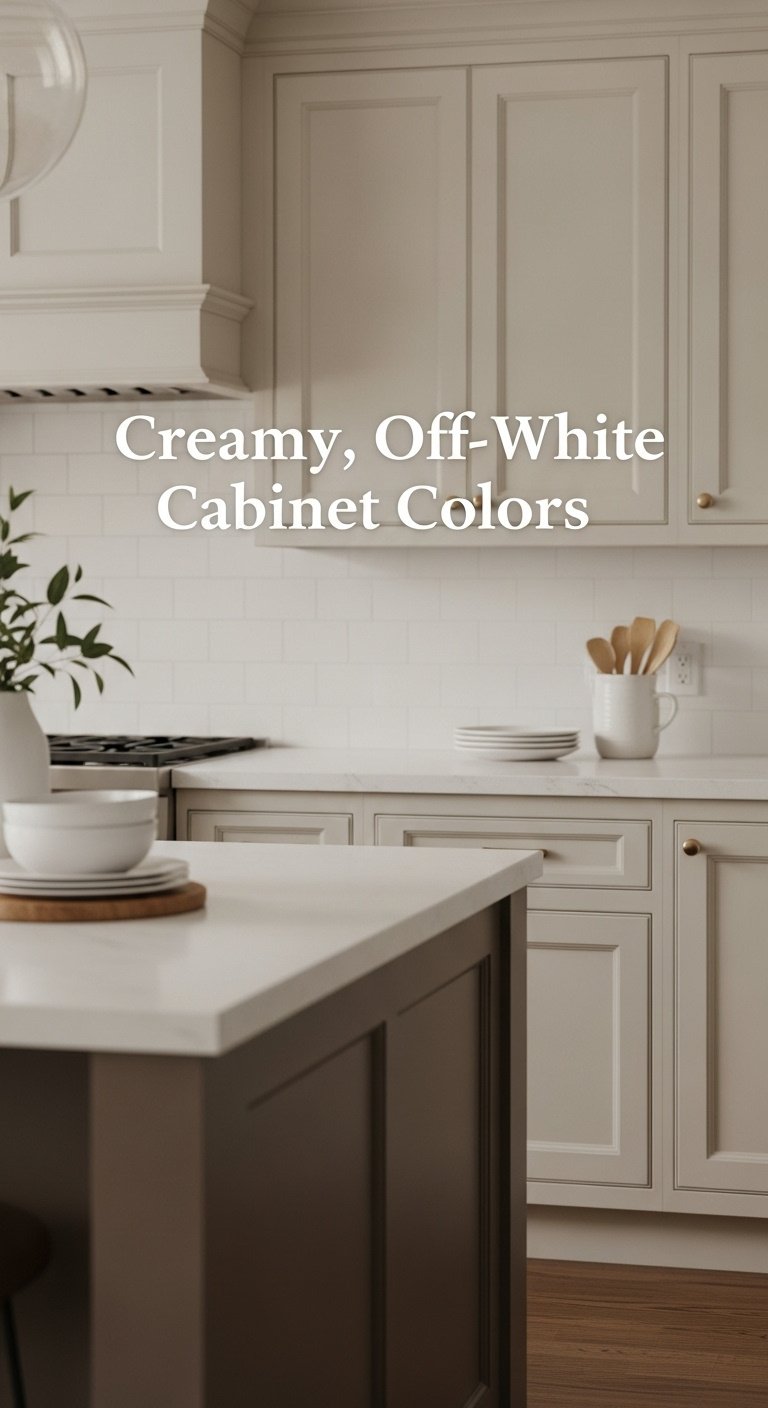
- Materials Needed: TSP or degreaser, sandpaper (120- and 220-grit), high-quality primer, cabinet-grade paint (e.g., Benjamin Moore ADVANCE), 2-inch angled brush, small foam roller, painter’s tape.
- Step-by-Step Directions:
- Prep is Key: Remove all hardware. Thoroughly clean cabinet doors and frames with a TSP solution to remove every trace of grease.
- Scuff Sand: Lightly sand all surfaces with 120-grit sandpaper to de-gloss the old finish. This gives the primer something to grip. Wipe away all dust.
- Prime: Apply one even coat of a high-adhesion primer. Let it dry completely according to the can’s instructions.
- First Coat: Apply your first coat of cabinet paint using the brush for crevices and the foam roller for flat surfaces. The key is thin, even coats. Avoid over-applying.
- Sand & Second Coat: Once dry, lightly sand with 220-grit sandpaper for a super-smooth finish. Wipe away the dust and apply your final coat. Let it cure for at least 48-72 hours before reattaching hardware.
Pro-Tip: In my experience, you should always test paint samples in your kitchen at different times of the day. A color like Sherwin-Williams Accessible Beige can look like the perfect greige in the morning sun but shift completely with your evening artificial light.
Pin this cabinet color idea to your ‘Dream Kitchen’ board!
2. Introduce Natural Wood Tones
To keep a neutral kitchen from feeling flat or sterile, you must introduce the warmth and texture of natural wood. This is a non-negotiable designer secret. It adds organic depth, connects the space to nature, and instantly makes the room feel more grounded and personal.
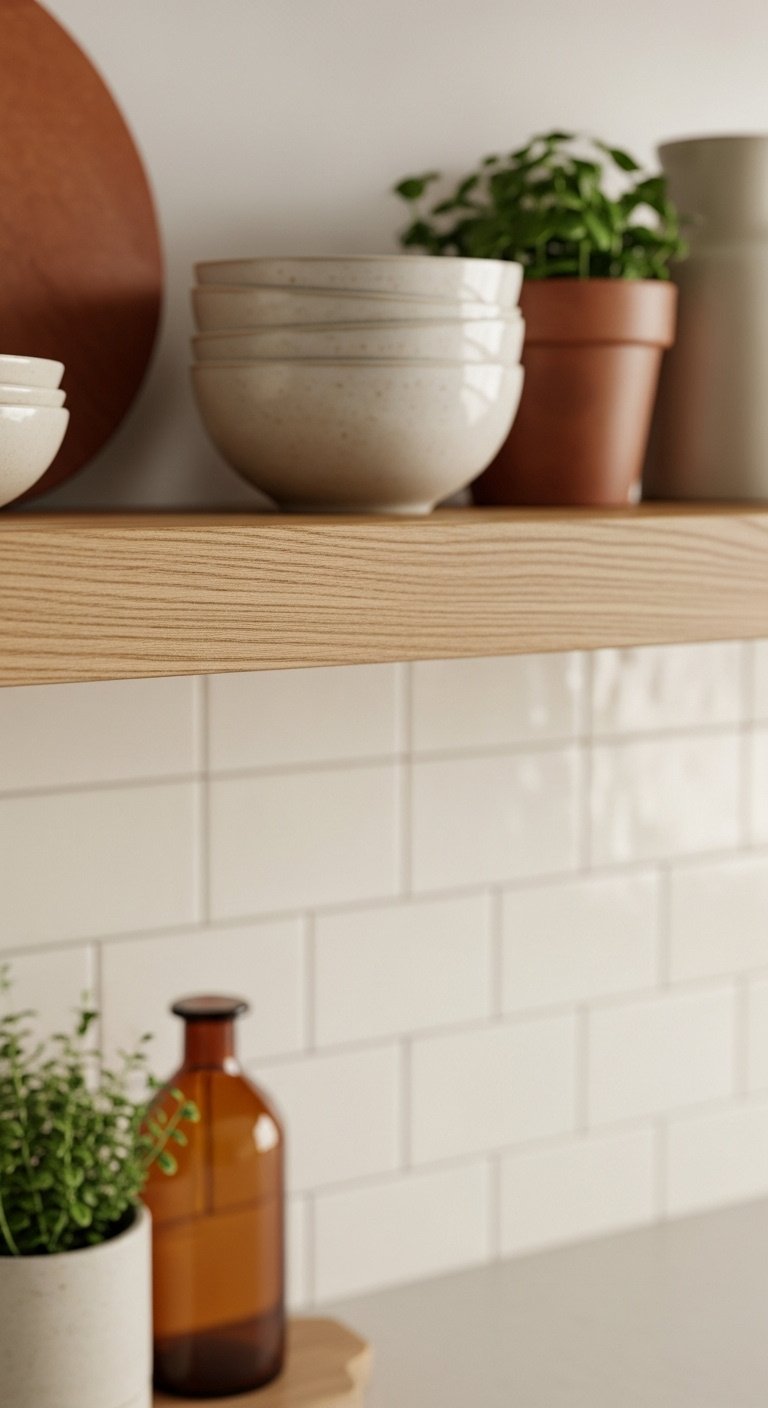
- Materials Needed: Floating shelf kit, stud finder, level, drill, wooden decor (acacia cutting boards, teak utensil holder).
- Step-by-Step Directions:
- Locate Studs: Use a stud finder to mark the location of wall studs where you plan to hang your shelf. This is crucial for stability, especially if you’re storing dishes.
- Mount Bracket: Hold the shelf’s mounting bracket against the wall, use a level to ensure it’s perfectly straight, and mark the drill holes over the studs.
- Drill & Secure: Drill pilot holes and then securely fasten the bracket to the wall using the provided screws.
- Slide & Style: Slide the wooden shelf onto the bracket. Style it with a mix of practical items (like everyday dishes) and decorative pieces (like a small plant or cookbook).
Pro-Tip: To keep wood looking rich and prevent it from drying out, I periodically treat all my cutting boards and butcher blocks with food-grade mineral oil. It’s a simple 5-minute task that brings out the natural grain beautifully.
Love this look? Save it to your ‘Kitchen Textures’ Pinterest board!
3. Upgrade to Warm Metallic Hardware
One of the fastest, easiest, and most cost-effective ways to make a kitchen look expensive is to swap out basic cabinet hardware for a warm metallic finish. This small detail acts as the “jewelry” of the kitchen, instantly elevating the entire space and giving it a custom, high-end feel.
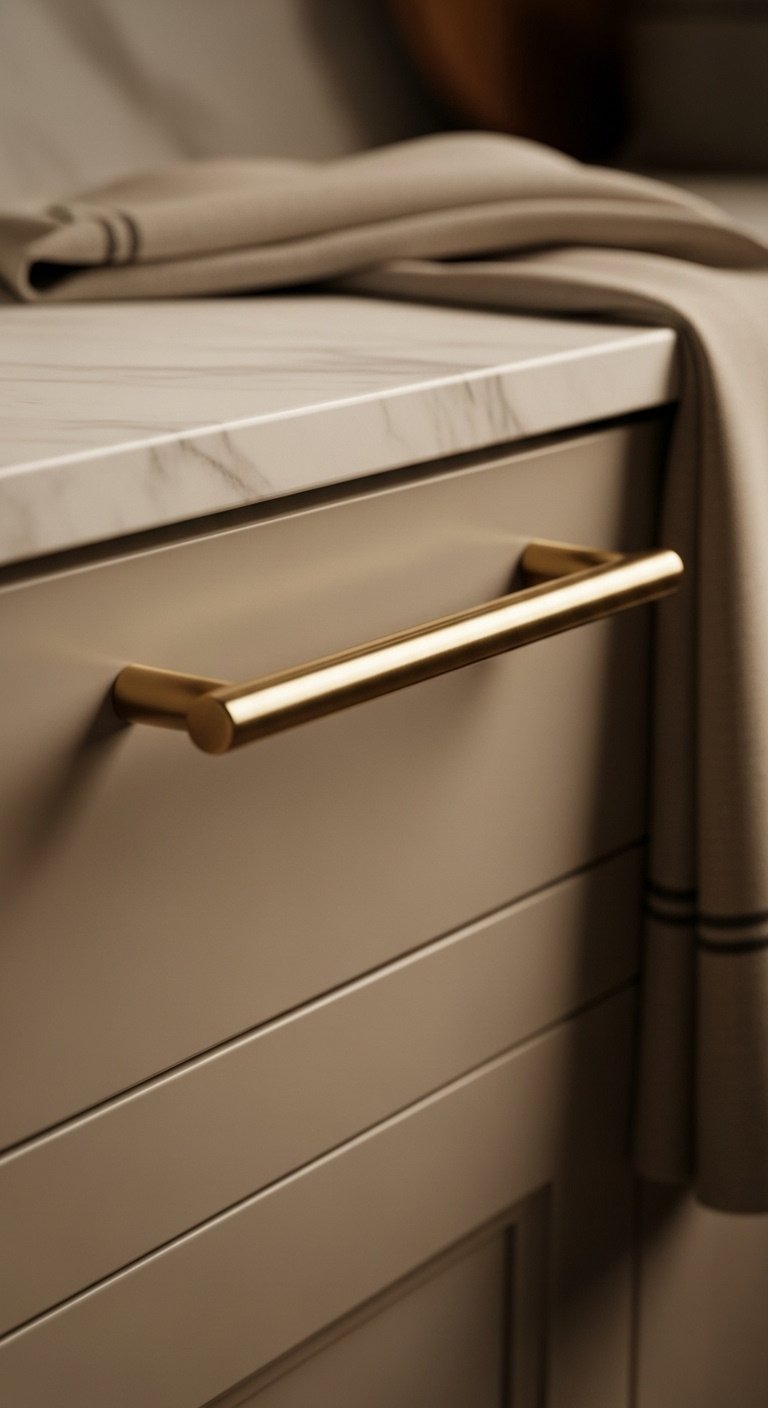
- Materials Needed: New cabinet hardware, screwdriver, template for new holes (if changing size), wood filler (if needed).
- Step-by-Step Directions:
- Measure First: Before you fall in love with new pulls, measure the center-to-center distance of your existing screw holes. Buying new hardware with the same measurement is the easiest possible upgrade.
- Remove Old Hardware: Simply unscrew the old knobs or pulls from the inside of the cabinet door or drawer.
- Fill (If Necessary): If your new hardware requires different holes, fill the old ones with wood filler, sand it smooth once dry, and touch up with paint before drilling new holes.
- Install New Hardware: Use a cabinet hardware template to ensure consistent placement across all doors and drawers. Screw in your new knobs or pulls from the back.
Lesson Learned: One thing I’ve learned is not to just look at the finish, but to feel the weight. Heavier, solid brass or steel hardware feels infinitely more substantial and luxurious than lighter, hollow alternatives. It’s a small detail that you’ll appreciate every time you open a drawer.
Find your perfect hardware! Pin this for inspiration.
4. Select a Backsplash with Texture and Sheen
A backsplash is a perfect opportunity to add personality, and choosing a tile with subtle texture or a soft sheen adds incredible depth. Materials that reflect light, even gently, make the kitchen feel brighter and more dynamic. This is where you can make a big statement without a huge footprint.

- Materials Needed: Peel-and-stick tile sheets, measuring tape, utility knife or sharp scissors, level.
- Step-by-Step Directions:
- Clean the Wall: Ensure the wall is perfectly clean, dry, and smooth. Remove outlet covers. Any grease or dust will prevent the tiles from adhering properly.
- Plan Your Layout: Measure the area and do a dry layout of the tiles on the counter to plan for any cuts. Use a level to draw a faint guideline for your first row.
- Peel and Stick: Peel the backing off the first tile sheet. Carefully align it with your guideline and press firmly onto the wall, smoothing from the center out.
- Overlap and Repeat: Overlap the grout lines of the next sheet with the first, following the manufacturer’s instructions to create a seamless look.
- Cut to Fit: Use a utility knife to score and snap tiles to fit around outlets, windows, and at the end of rows.
Pro-Tip: For a truly high-end look that I absolutely love, consider handmade-style tiles like Zellige. Their subtle imperfections and beautiful variations in glaze catch the light in a unique way, adding incredible depth and character that machine-made tiles just can’t replicate.
Add this textured backsplash idea to your ‘Kitchen Renovation’ board!
5. Implement Layered, Warm Lighting
Designer kitchens always feel so inviting because they use layered lighting to create ambiance and functionality. A single, harsh overhead light can make any space feel flat. By combining different light sources, you create depth, highlight key features, and can tailor the mood of the room from bright and functional to soft and relaxing.
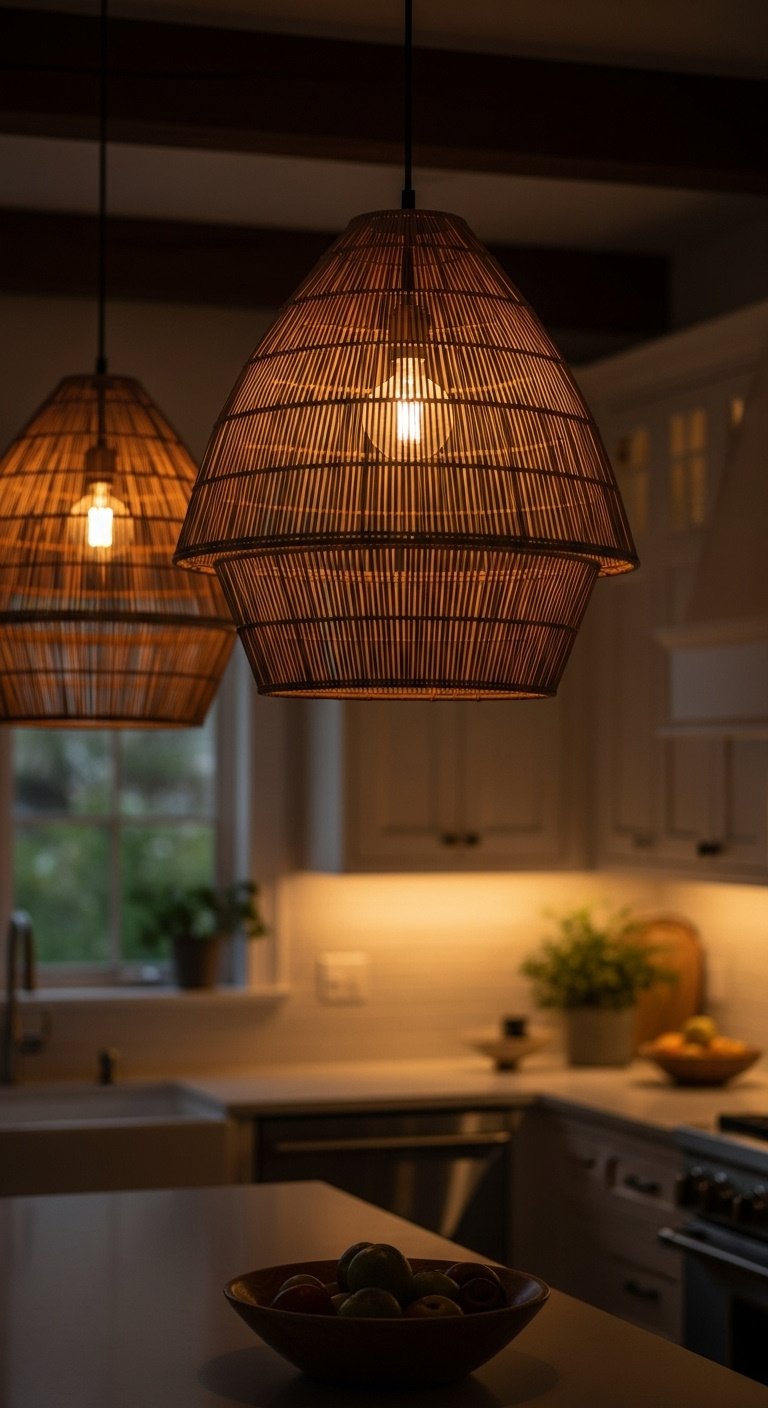
- Materials Needed: Plug-in or battery-powered LED under-cabinet light strips, measuring tape, cleaning cloth.
- Step-by-Step Directions:
- Measure and Clean: Measure the underside of your cabinets to determine the length of LED strips needed. Thoroughly clean the surface where you’ll be mounting them.
- Adhere the Strip: Peel the adhesive backing from the light strip. Press it firmly into place on the underside of the cabinet, usually towards the front to illuminate the countertop best.
- Connect Power: For plug-in versions, run the cord discreetly to the nearest outlet. For battery-powered versions, ensure the battery pack is accessible for changes.
- Add a Statement Piece: Complement your new task lighting by swapping a basic ceiling fixture for a large, statement pendant light over your island or dining area. This creates a beautiful focal point.
Pro-Tip: My number one piece of advice for lighting is to always install dimmers. The ability to control the light intensity is the single biggest factor in creating a luxurious, moody atmosphere for evening entertaining or a bright, functional space for cooking. It’s a small electrical job that pays huge dividends in ambiance.
Light up your life! Save this lighting scheme to your Pinterest board.
6. Choose Countertops with Warm Veining
While a full countertop replacement can be a major expense, choosing a material with subtle warm veining makes a huge difference in the overall feel. If you’re upgrading, look for quartz or marble-look designs with gold, beige, or brown undertones instead of cool blue or gray. For a budget fix, high-quality vinyl wraps can work wonders.
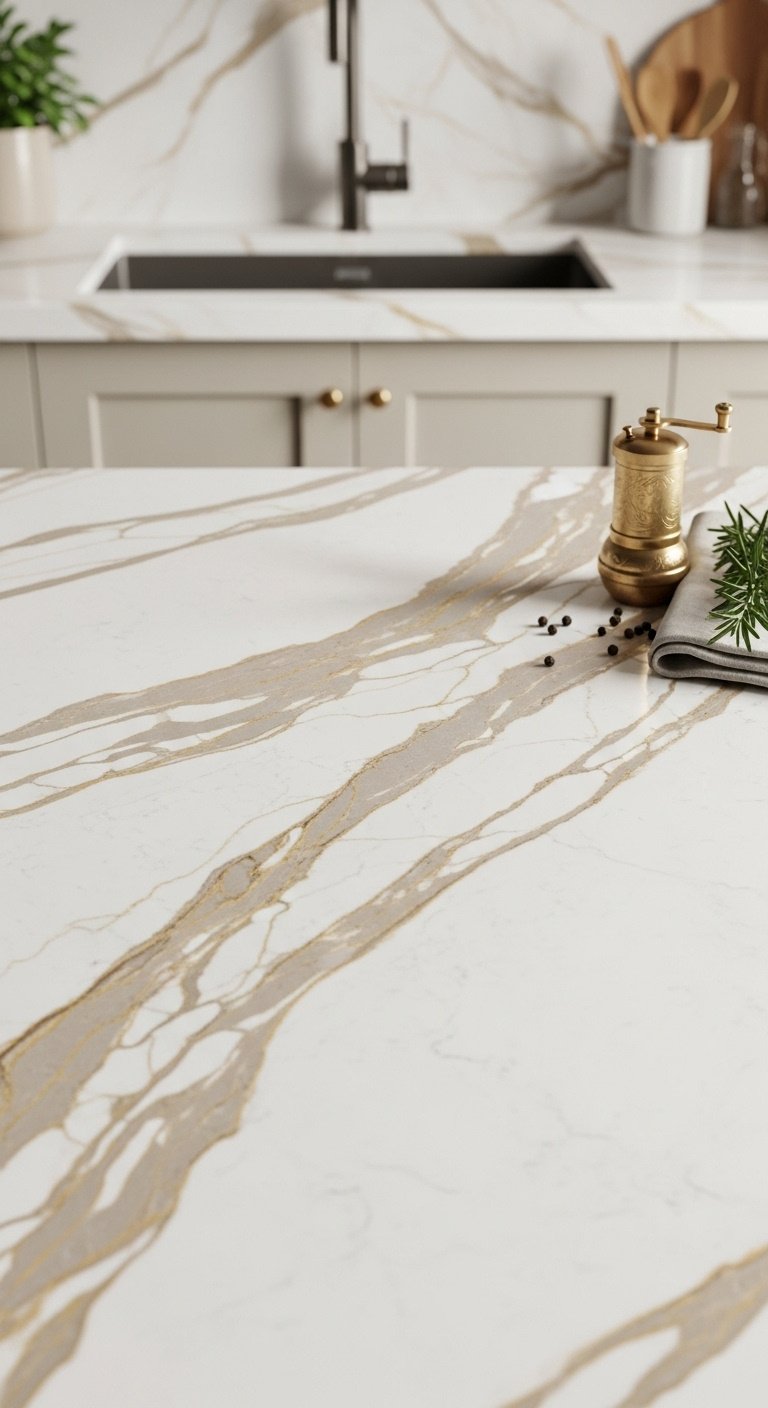
- Materials Needed: High-quality marble-effect vinyl wrap, measuring tape, squeegee, utility knife, heat gun or hairdryer.
- Step-by-Step Directions:
- Deep Clean: Thoroughly clean and degrease your existing countertops. The surface must be perfectly smooth and dry for the best adhesion.
- Measure and Cut: Measure your countertop and cut the vinyl wrap, leaving a few inches of excess on all sides.
- Apply Slowly: Peel back a small section of the backing paper. Align the vinyl with one edge of the countertop and use a squeegee to smooth it down, pushing out air bubbles as you go. Slowly pull off more backing while continuing to smooth.
- Handle Edges: Use a heat gun or hairdryer to gently warm the vinyl as you wrap it around the edges and underside of the countertop. This makes it more pliable for a seamless look.
- Trim Excess: Use a sharp utility knife to carefully trim the excess vinyl from the underside.
Pro-Tip: When I’m helping clients choose quartz, I always tell them to look for designs with subtle gold or brown veining instead of cool gray. Brands that use “Calacatta Gold” in the name, or designs with words like “beige” or “cashmere,” often have the exact warmth you’re looking for to complement neutral cabinets.
Dreaming of new countertops? Pin this beautiful option!
7. Accessorize with Earthy, Handcrafted Decor
An expensive-looking kitchen feels curated and personal, and the fastest way to achieve this is with thoughtfully chosen, textured decor. Move away from generic, mass-produced items and look for pieces that feel earthy and unique. This is how you inject soul into your space.
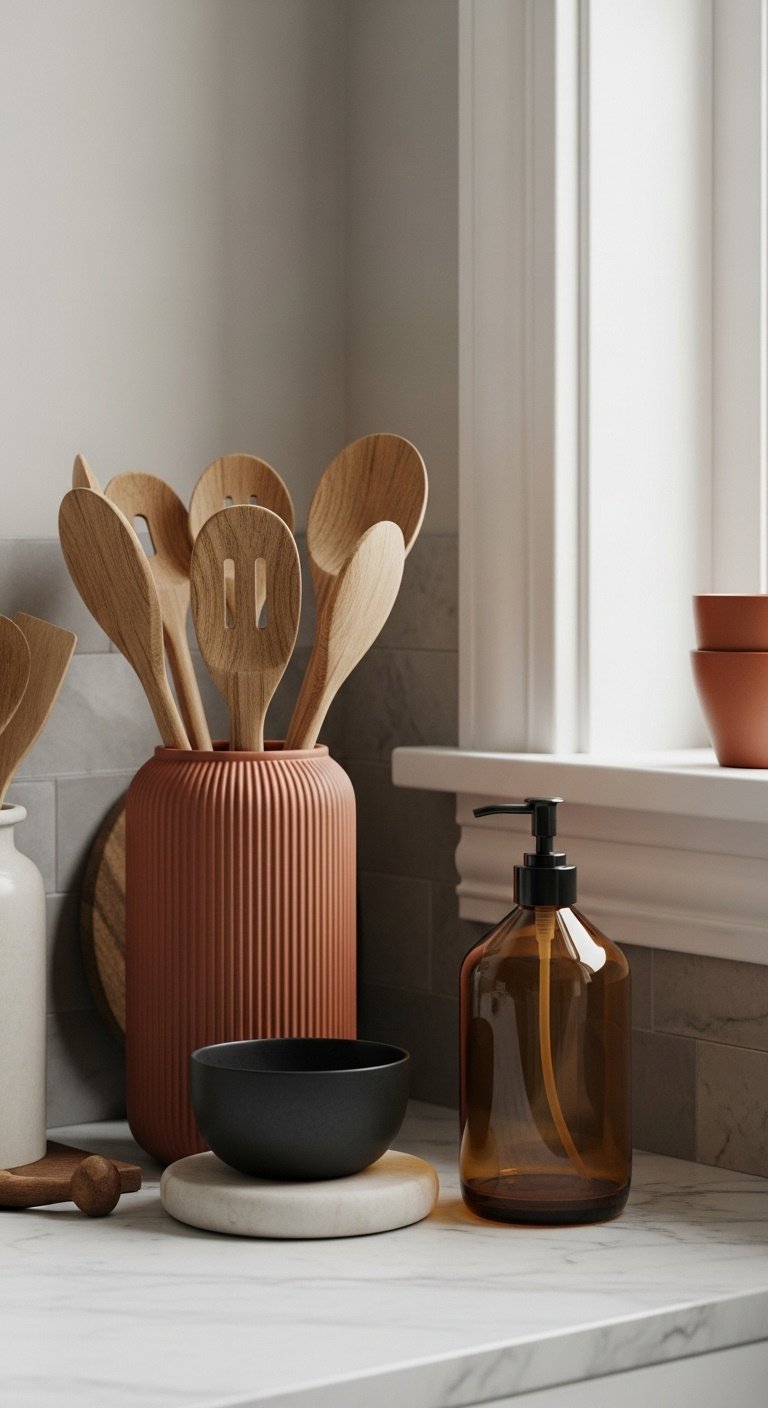
- Materials Needed: A collection of 3-5 decor items, a tray or large cutting board to group them.
- Step-by-Step Directions:
- Create a “Vignette”: Choose a corner of your countertop or a section of open shelving to become a styled moment.
- Anchor with a Tray: Place a round wooden cutting board or a shallow tray down as a base. This simple step makes the collection feel intentional and contained.
- Vary Height: Group items of varying heights. For example, a tall ceramic vase for utensils, a medium-sized canister for coffee, and a small, low bowl for salt.
- Mix Textures: Combine different materials, like a rough stoneware vase next to a smooth wooden salt cellar or a ribbed ceramic piece.
- Add Life: Finish with a natural element, like a small potted plant or a few dried branches in the vase.
Pro-Tip: I always follow the ‘Rule of Three.’ Grouping items in odd numbers, especially threes, is almost always more visually appealing and balanced than grouping in even numbers. It creates a dynamic that feels more natural to the eye.
Get this curated look! Save this styling idea to your ‘Home Decor’ board.
8. Lay Down a Vintage-Inspired Runner
Kitchen floors are often overlooked, but adding a runner with a warm, vintage-inspired pattern instantly adds softness, color, and a cozy, lived-in feel. It’s a fantastic way to break up a large expanse of wood or tile and make the space feel more like a decorated room.
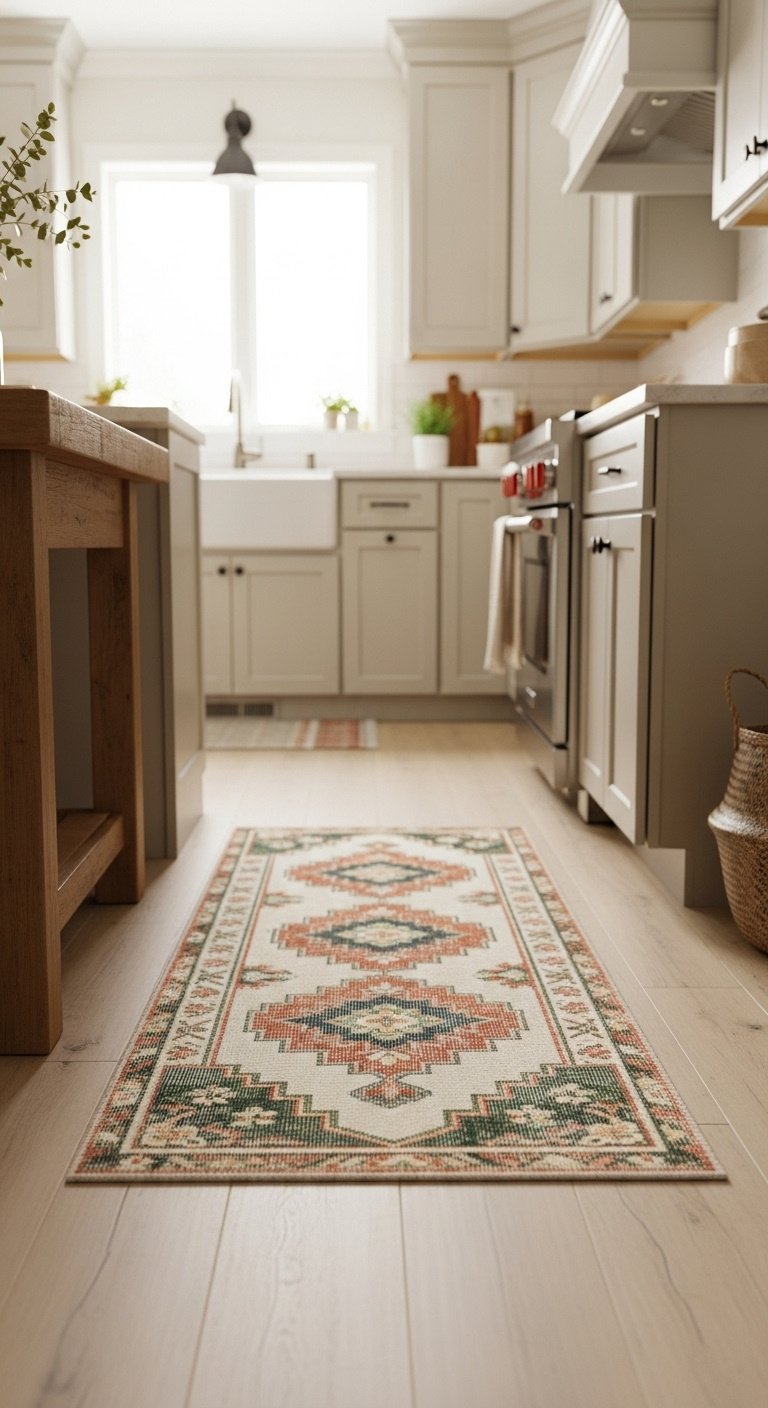
- Materials Needed: Measuring tape, rug pad, kitchen runner.
- Step-by-Step Directions:
- Measure Your Space: Measure the length and width of the floor space you want to cover, typically in front of the sink and main prep area. A standard runner size is around 2.5′ x 8′ or 10′.
- Prioritize Washability: For a kitchen, I can’t stress this enough: choose a rug that is explicitly labeled as machine-washable. This is non-negotiable for handling inevitable spills and splatters.
- Choose Warm Colors: Select a pattern with a warm color base—think muted reds, oranges, tans, and browns—to complement your neutral cabinets and add a pop of personality.
- Add a Rug Pad: Place a non-slip rug pad underneath. This prevents the runner from sliding around dangerously and adds a little extra cushion underfoot.
Lesson Learned: Please don’t skip the rug pad! In my first apartment, I tried to save a few dollars and went without one. The rug was constantly crooked and I slipped on it more than once. A good pad is not just for comfort; it’s a safety essential that also extends the life of your runner.
Warm up your floors! Pin this rug idea now.
9. Decant and Declutter for a Streamlined Look
Nothing makes a kitchen look cheaper than cluttered countertops filled with mismatched packaging and appliances. An expensive-looking kitchen is an organized kitchen. Taking the time to decant essentials and ruthlessly declutter your surfaces is a completely free way to elevate your space.
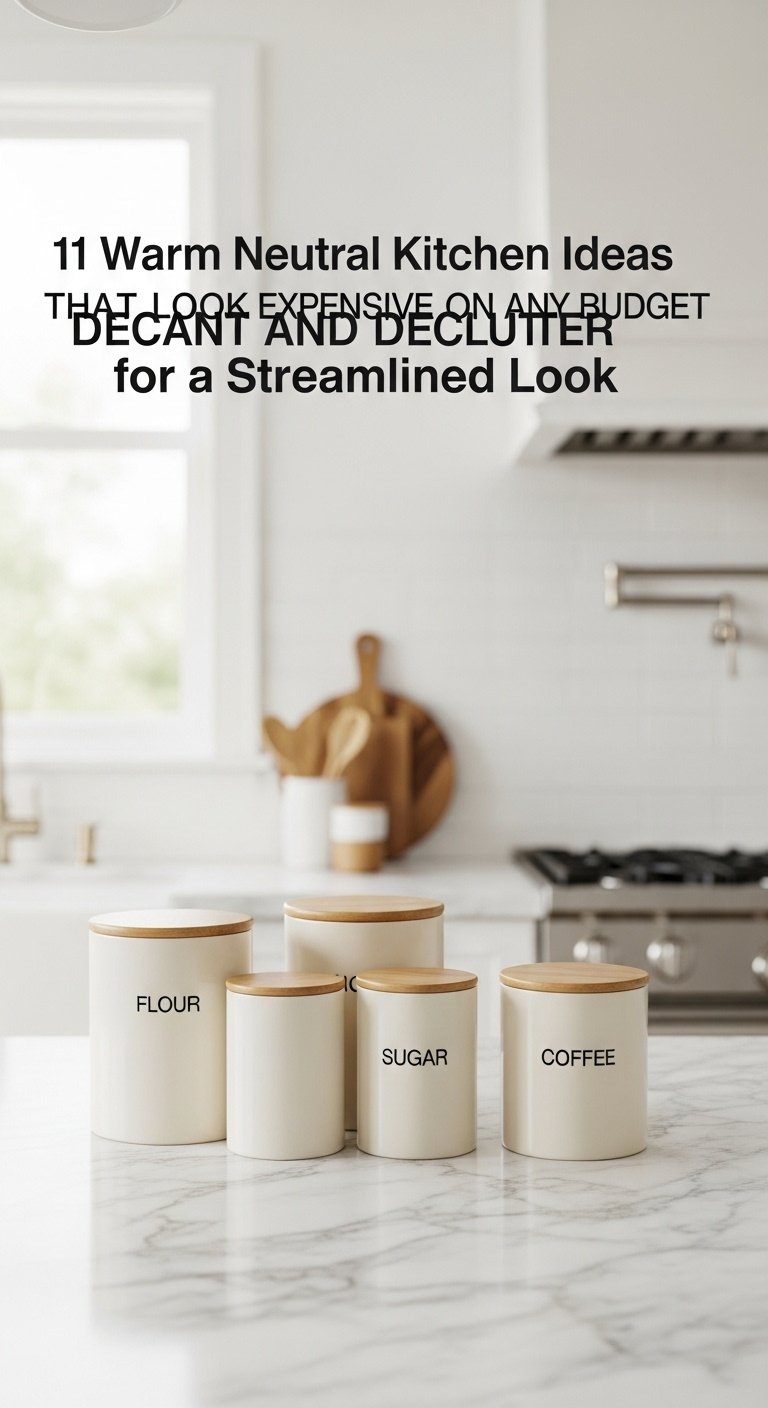
- Materials Needed: Glass or ceramic canisters with wood lids, a label maker or chalk pen, drawer inserts for spices or utensils.
- Step-by-Step Directions:
- Clear Everything: Start by completely clearing off your countertops. Everything.
- Be Ruthless: Only put back what you use every single day (like your coffee maker). Store occasional-use appliances (like a stand mixer or blender) in a pantry or cabinet.
- Decant Dry Goods: Transfer items like flour, sugar, coffee, and pasta from their chaotic commercial packaging into uniform, attractive canisters.
- Label Everything: Use a simple label maker to create clean, minimalist labels for your canisters and spice jars. Consistency is key.
- Corral Items: Use a small tray to group items that must stay on the counter, like olive oil, salt, and pepper next to the stove.
Pro-Tip: An “appliance garage”—a cabinet that sits on the countertop with a lift-up or sliding door—is a designer secret for hiding things like toasters and coffee makers while keeping them easily accessible. It’s the ultimate solution for a streamlined look.
Ready to organize? Save this decluttering tip!
10. Make the Faucet a Sculptural Focal Point
Much like cabinet hardware, a faucet is a functional item that can have a huge design impact. Upgrading a basic builder-grade faucet to a more sculptural, modern design in a warm finish like brass or matte black can instantly make your entire sink area a sophisticated focal point.
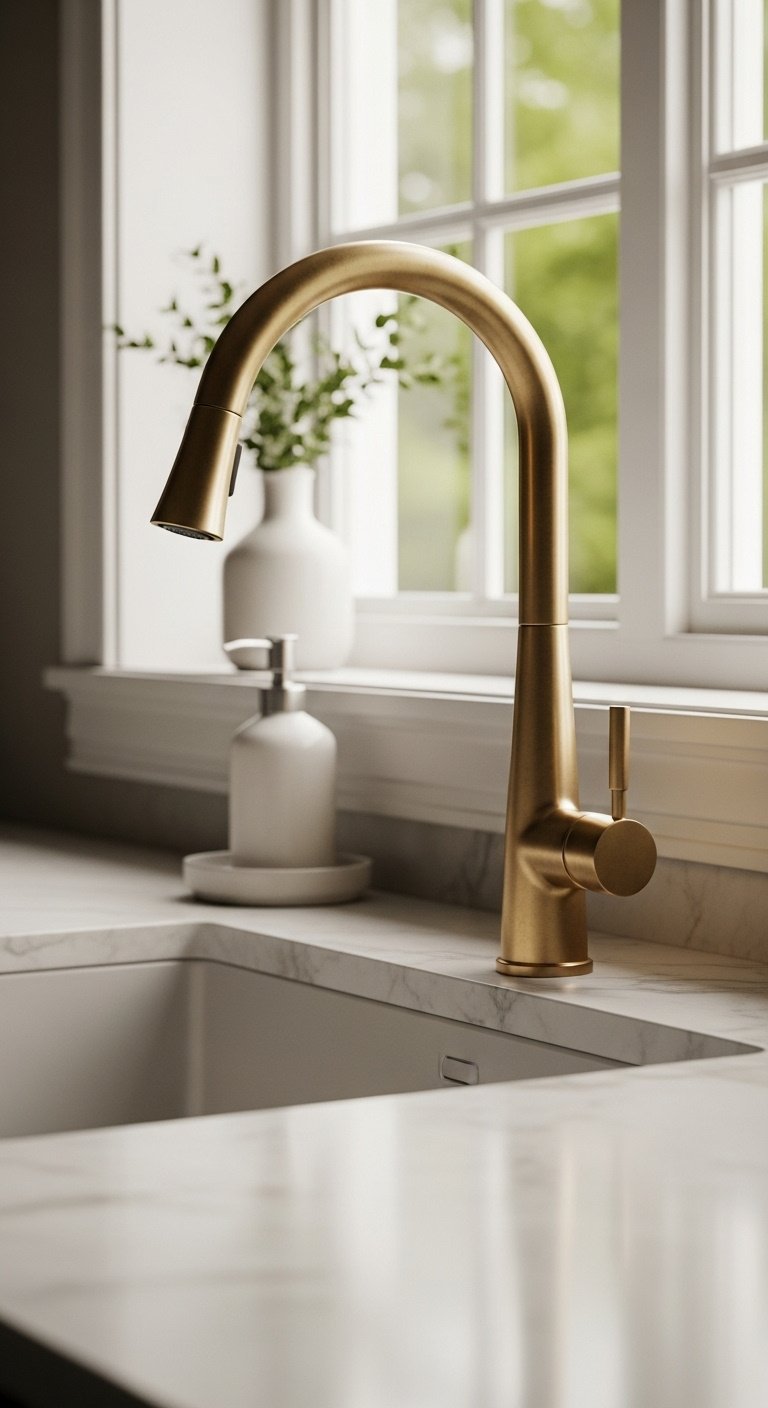
- Materials Needed: New faucet, basin wrench, adjustable wrench, bucket, cleaning rags.
- Step-by-Step Directions:
- Turn Off Water: Shut off the hot and cold water supply valves under the sink. Turn the old faucet on to release any remaining pressure.
- Disconnect Lines: Place a bucket under the pipes to catch drips. Use a wrench to disconnect the water supply lines from the old faucet.
- Remove Old Faucet: This is where the basin wrench is your best friend. Use it to loosen the mounting nuts holding the old faucet in place from underneath the sink, then remove the old faucet.
- Install New Faucet: Clean the sink surface. Following the manufacturer’s instructions, insert the new faucet into the mounting hole(s) and tighten it from below.
- Reconnect & Check: Reconnect the water supply lines. Turn the water back on slowly and check thoroughly for any leaks around all connections.
Pro-Tip: From my own experience, look for faucets with features like a magnetic docking spray head. It’s a small detail that feels incredibly high-end in day-to-day use and prevents the sprayer from drooping over time, which is a pet peeve of mine!
Pin this stunning faucet to your ‘Kitchen Finishes’ board!
11. Bring Life in with Potted Herbs and Greenery
The final layer in any well-designed room is life. Adding simple pots of greenery or fresh herbs instantly breathes life into a kitchen, adding a pop of natural color and reinforcing the warm, organic feel of the space. It’s the easiest and most affordable way to make a kitchen feel vibrant and cared for.
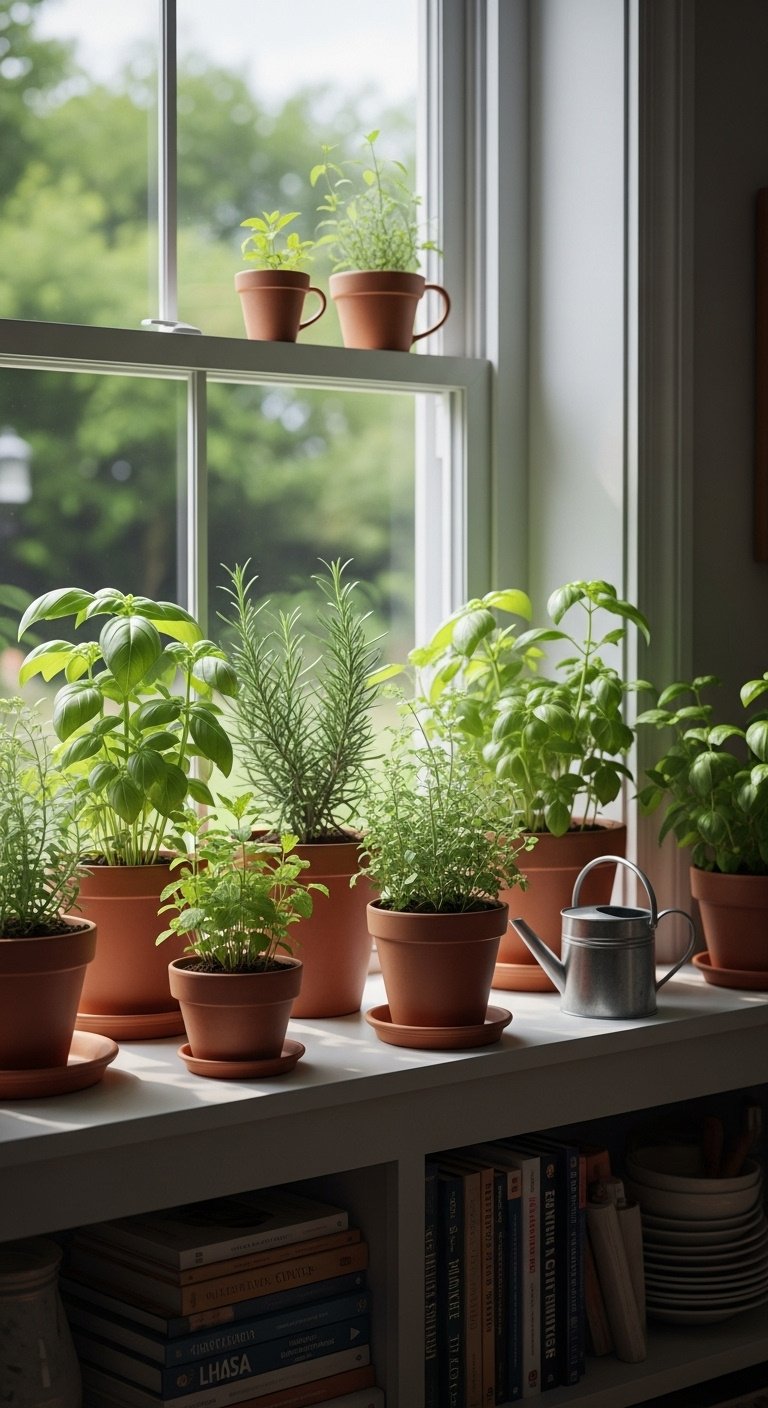
- Materials Needed: Small terracotta pots with drainage holes, potting mix, herb seedlings (e.g., basil, mint, rosemary), a small tray or saucer.
- Step-by-Step Directions:
- Choose a Sunny Spot: Find the sunniest windowsill in your kitchen. Most herbs need at least 6 hours of direct sunlight per day to thrive.
- Pot Your Herbs: Fill the terracotta pots with a good quality potting mix. Gently remove the herb seedlings from their nursery containers and plant them in the new pots.
- Water Thoroughly: Water the newly potted herbs until water runs out of the drainage holes. Place the pots on a tray or individual saucers to protect your windowsill.
- Style Them: Group the pots together for a more impactful look. The warm, earthy color of the terracotta will perfectly complement a neutral kitchen palette.
Lesson Learned: Trust me on this: don’t overwater! It’s the most common way people kill their indoor herbs. I learned the hard way to let the top inch of soil dry out completely before watering again. Your basil will thank you.
Add a touch of green! Save this kitchen herb garden idea.
Key Takeaways: Your Quick Guide to a Warm Neutral Kitchen
Feeling inspired but need a quick recap? Here are the core principles for achieving an expensive-looking warm neutral kitchen on a budget.
- Focus on Warm Undertones: Always choose paints like greige, cream, and taupe over stark whites and cool grays to create an inviting base.
- Layer Textures: Combine smooth painted cabinets with organic materials like natural wood, woven textiles, and glossy tiles to create visual depth and interest.
- Upgrade Key Touchpoints: Invest in high-impact, low-cost items like solid cabinet hardware and a sculptural faucet to create a custom, high-end feel.
- Control the Lighting: Implement layered lighting with dimmers to switch between bright, functional task lighting and a warm, moody ambiance for the evening.
- Declutter and Curate: A clean, organized space with thoughtfully chosen accessories instantly looks more intentional, sophisticated, and expensive.
People Also Ask About Warm Neutral Kitchens
What is the best color for a neutral kitchen?
The best colors for a warm neutral kitchen are shades like creamy off-white, beige, taupe, and greige. These colors have warm undertones that create a cozy and inviting atmosphere. Popular paint choices include Benjamin Moore’s Swiss Coffee and Sherwin-Williams’ Accessible Beige, which provide a sophisticated backdrop that feels both timeless and fresh for 2025.
How do you warm up a neutral kitchen?
To warm up a neutral kitchen, introduce natural textures and materials. Incorporate wood elements through cutting boards, floating shelves, or butcher block countertops. Upgrade cabinet hardware to warm metals like brushed brass or champagne gold. You can also add textiles like a vintage-inspired runner and layer in warm, dimmable lighting to create an inviting ambiance.
What is the 2025 kitchen color?
For 2025 and 2025, kitchen color trends are shifting decidedly towards warm neutrals and earthy tones. Expect to see beige, sand, and taupe creating calm, grounded spaces. Additionally, subtle olive greens and rich terracotta tones are popular for adding a touch of rustic warmth and a biophilic connection to nature, signaling a move away from the cool grays of previous years.
Final Thoughts
Creating a kitchen that looks and feels luxurious doesn’t have to be a dream reserved for an unlimited budget. It’s about making smart, intentional choices. By embracing a warm neutral palette, layering in rich textures, and focusing on those small but mighty upgrades, you can completely transform your space. You have the power to create a kitchen that not only looks expensive but feels like the true, welcoming heart of your home.
Which of these warm neutral ideas are you excited to try first? Let us know in the comments below
